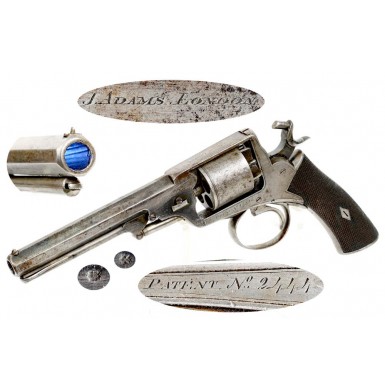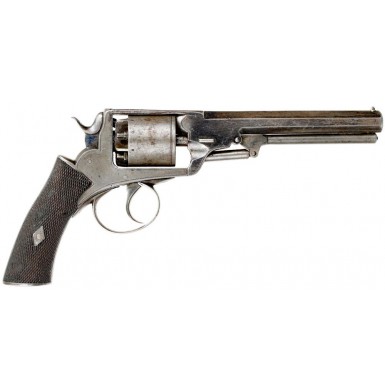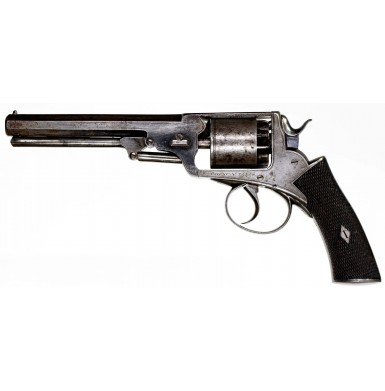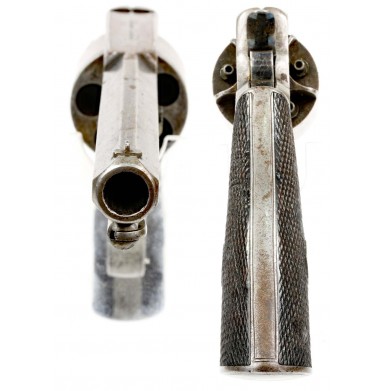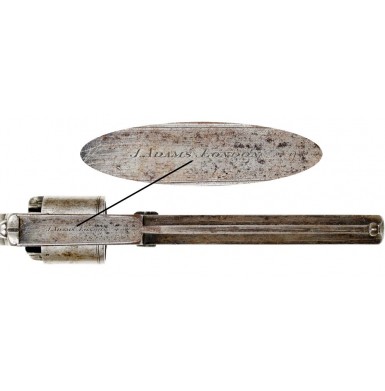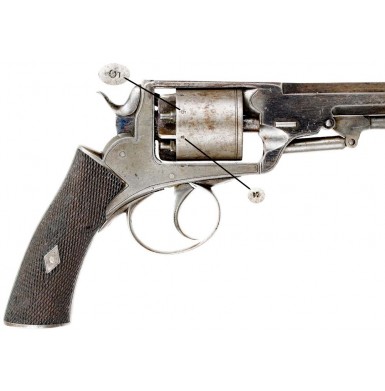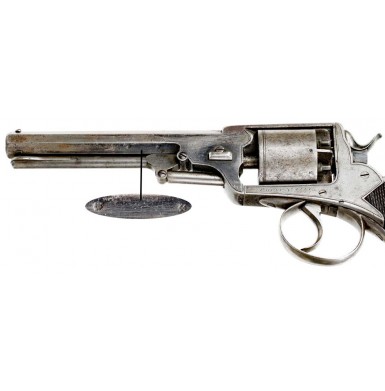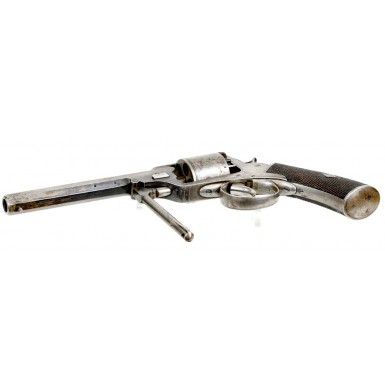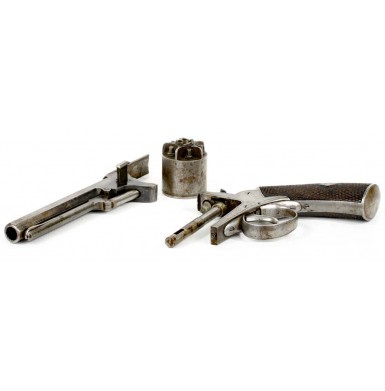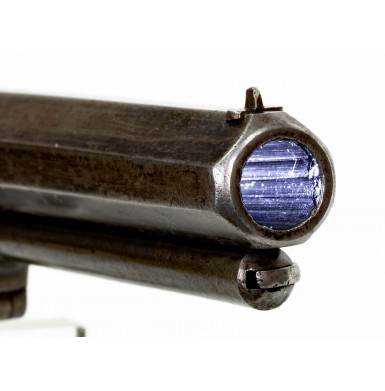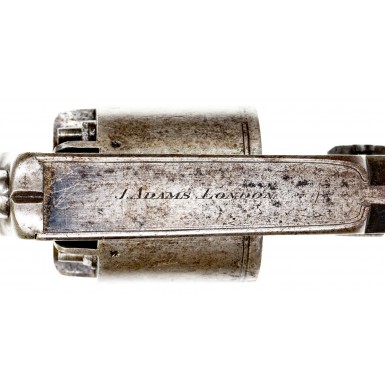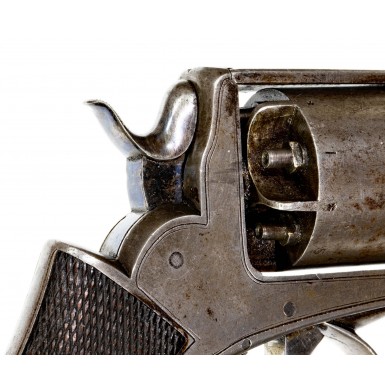Wonderful Published Example of a Confederate Imported Webley Wedge Frame Revolver from The English Connection
- Product Code: FHG-2329-SOLD
- Availability: Out Of Stock
-
$1.00
This is a NEAR FINE example of the English Webley Wedge Frame double-action percussion revolver, as produced from the late-1850s through the mid-1860s. These guns provided less expensive alternatives to the Adams and Tranter patent revolvers of the day. The primary cost savings was in the use of a two-piece frame and barrel design, similar to Colt revolvers, with the two parts held together via a “wedge”. Adams and Tranter revolvers utilized a one-piece frame and barrel assembly that was forged from a single piece of iron and were much stronger and less prone to breakage and wear with age. The one-piece design could not “shoot loose” with repeated use, as wedge secured two-piece revolvers could. The “wedge” frame design is attributed to Birmingham gun maker Philip Webley, although Webley himself seemed to have manufactured very few of the guns. The simplified double-action lock mechanism typically encountered in these revolvers is usually of the Joseph Bentley design, and these guns are often referred to as Webley-Bentley revolvers, even though they were produced by many Birmingham gun makers and are often unmarked.
This Webley wedge frame is very well made and has an action more akin to that of the Beaumont-Adams than the typical Bentley style double-action only mechanism. The gun has a top strap over the cylinder to reinforce the frame, a feature missing from most Webley-Bentley guns. The gun is typical of larger bore English double-action revolvers in that it features a five-shot cylinder. As is typical of Webley style guns, this one has numbered cylinder chambers, as well as the expected Birmingham commercial proofs between each chamber. The revolver has a 6 3/8” long barrel octagon barrel and is chambered in the popular English 54-bore, which is about .442 caliber. As previously noted, the action is more akin to the Beaumont-Adams lockwork of the era, and the gun is a “conventional” double action revolver. It operates as a standard double action by pulling the trigger, which rotates the cylinder, cocks the hammer and releases it, all with one long, heavy trigger pull. The action also allows for more precise shooting. By thumb cocking the hammer and firing the gun in single action mode, a lighter trigger pull is available. In typical English revolver style, the cylinder only “locks up” when the trigger is pulled completely back (in double action mode) or when the hammer is locked in the fully cocked position (single action mode). This eliminates the need for a spring actuated cylinder stop in the bottom of the frame, a feature typical of American guns of the era like those of Colt and Remington. While some of the Webley “wedge” style guns utilize a Colt style, under barrel loading lever, others used the decidedly English pattern lever, similar to the Kerr Patent lever found on many Adams revolvers. This revolver uses the Colt style lever, which is typical of guns in this serial number range. Earlier guns are usually encountered with the Kerr style, side mounted lever. Top strap markings on this pattern of revolver vary greatly. Extant examples of this style of Webley Wedge Frame revolver are known with no markings on the top strap, with simply the word LONDON, and with the names P WEBLEY & SON, D. BENTLEY PATENT and J ADAMS , which is found both with and without the additional word “LONDON”. A handful of examples of similar English double action revolvers are known with pre-war Southern retailer marks, usually from New Orleans. New Orleans seems to have been a major source for imported English revolvers prior to the Civil War. Extant examples include guns retailer marked by Thomas Bailey of New Orleans. At least three variations of Bailey’s mark are known on Wedge Frame revolvers.
This example is engraved J. ADAMS LONDON on the topstrap. John Adams appears to have been the cousin of Robert Adams and not his brother as is so often believed. The extensive research into English census records done by Chamberlain & Taylerson in their exhaustive study Adams’ Revolvers lays out this theory quite convincingly. John worked with Robert and on his own, and apparently worked closely with Birmingham gunmakers as well, often retailing arms made in there under his own name. He had been employed at the London Armoury Company with Robert, and when Robert left L.A.C., so did John. John held a patent for a double action percussion revolver design, the Model 1857, but this revolver apparently saw minimal production. In this case, his name on the topstrap simply indicates that John Adams of London was the retailer of the gun. The lower left side of the frame of this revolver is engraved simply PATENT No 2444, below the cylinder. The only other markings are the previously noted Birmingham commercial proofs on cylinder and a pair of Birmingham commercial proof on the lower left angled flat of the barrel.
These reliable and reasonably priced double-action revolvers were popular export items and were available for sale around the world. Confederate purchasing agents acquired these revolvers, as they were much less expensive than the competing Adams, Tranter & Kerr patterns. The Pratt Roll, which is an inventory list of revolvers that details the 15 handguns in the possession of Company H of the 18th Virginia Cavalry in July of 1864 lists 3 Webley and/or Bentley revolvers, as well as 4 guns of “unknown” pattern. The balance of the revolvers on the list are 7 Kerr’s patent revolvers & 2 Tranter pistols. The Bentley numbers on the list are 3111 and 3221, while the Webley revolver is number 5054. This indicates that even in this small sample of CS used revolvers, 20% were of the Webley and/or Bentley patterns. As the average company grade officer would probably not be familiar with the names and patterns of English revolver manufactures, other than possibly Adams and Tranter, I have a feeling that the guns were identified by the maker or retailer name on the topstrap of the revolvers. This suggests that #3111 and #3221 were likely “D Bentley” marked Wedge Frame revolvers, and #5054 was probably a P. Webley marked Wedge Frame. The “unknown” revolver with serial number #3563 was almost certainly a wedge frame revolver as well, but with no retailer mark on the top strap. The “unknown” revolvers with serial numbers 33,609 and 36,604 were almost certainly Adams patent M1854 revolves, also with blank top straps. Based upon the very small sampling of likely “Wedge Frame” revolvers on the Pratt List, this revolver falls about 700 numbers below the “Bentley” marked guns in the low 3,XXX range. While there are no direct Confederate Central Government contracts known for this pattern of revolver, some Confederate correspondence exists that suggest the more reasonably priced double action revolvers (in both 80 bore and 54 bore) were purchased primarily by speculators for importation to the Confederacy. It appears that most of these guns were imported through Mexican or Texas ports and many saw use in the Western Theater as well as the Trans-Mississippi Theater. It is believed that the revolvers delivered by Nelson Clements, who had a contract to deliver 5,000 revolvers to the Houston Quartermaster, were of the wedge frame pattern. A handful of guns that appear to have been part of his deliveries are known, and they are in the low 2,XXX serial number range, and obviously numbers above and below that point would be potential Clements contract arms due to the size of the order. Additionally, examples of Webley Wedge Frame double action revolvers exist with Confederate provenance. These include several well-documented Webley Wedge Frame revolvers in museum collections. The gun of Colonel John Smith of the 20th Alabama Infantry (ex-Bond collection) is one such example, as is one reported to be engraved to General William Mahone. Both pistols are in the National Civil War Museum (formerly the Museum of the Confederacy) collection, to the best of my knowledge. Another Webley Wedge Frame revolver, formerly in the famous Richard Steuart Collection, resides at the Virginia Historical Society in Richmond. The Webley Wedge Frame revolver #5553 is identified to Captain George Russell, the quartermaster of the 47th TN Infantry Regiment.
This double action Webley Wedge Frame is a classic “export” revolver and is unmarked externally except for previously mentioned J. ADAMS LONDON retailer’s mark engraved on the topstrap, the chamber numbers on the cylinder chambers, Birmingham proofs on the barrel and cylinder, and PATENT No 2444 engraved on the left side of the frame. The gun was previously in the collection of author and researcher R.A. Pritchard Jr. and a picture of the gun’s topstrap marking is found on page 246 of The English Connection, the book by Mr. Pritchard and a team of authors and researchers, which documents the and discusses the arms and equipment imported by the Confederacy from Great Britain. I am proud to be one of the contributing authors to this project.
The gun remains in NEAR FINE and retains about 20%+ of its original blued finish on the barrel, with the topstrap, frame and cylinder retaining no original finish to speak of and having a mostly smooth pewter patina with scattered mottled plum brown and oxidized discoloration mixed over the metal surfaces. The barrel, top strap and cylinder show some very minor scattered pinpricking and lightly oxidized surface freckling, mostly around the chamber mouths and in the percussion cone recesses, and on the topstrap above the chamber mouths and forcing cone. Some similar pinpricking and light pitting is present around the muzzle and is lightly scattered here and there on the balance of the revolver. The hammer of this gun retains about 30%+ of its original bright niter blued finish. Other examples are known where the hammer was left in the white and brightly polished, and some are known with case hardened hammers. As would be expected with a lower cost, “working man’s” revolver, this one shows none of the lightly engraved embellishments typical of Adams and Tranter revolvers, with the only aesthetic addition being a pair of lightly engraved boarder lines that trace the outline of the revolver frame, cylinder face and muzzle. The loading lever is an under-barrel, Colt style lever with a pin retention system rather than the Colt wedge shaped catch. The finish on the lever is mostly worn, having flaked and dulled, blending with a smoky gray color with some muted highlights of original case coloring still visible in protected areas near the frame. The revolver is fully functional and is mechanically excellent. The pistol functions perfectly in both single action and double action modes. The gun times and indexes exactly as it should and has very tight lock up. The loading lever functions smoothly and locks into place securely. The bore of the revolver rates about FINE. It is mostly bright and retains very crisp rifling that consists of sixteen lands and grooves, with the grooves approximately half the width of the lands. There is some very light frosting in the grooves, and some lightly scattered pinpricking and some lightly scattered minor pitting but otherwise no significant wear and certainly no abuse; showing that while the revolver was used, it was very well cared for. The revolver retains all five of its original percussion cones (nipples), which show some erosion from firing and use, but remain very crisp and useable today. The original dovetail mounted front sight is in place on the top of the barrel, near the muzzle as well. The two-piece checkered wood grips are in about NEAR FINE condition as well. They show some use and wear, with some minor flattening and smoothing of the checkering from carry and handling. The grips are in solid condition, with no breaks, cracks or repairs noted. The grips show wear commensurate with the flashing erosion found on the rear of the cylinder in the cone (nipple) recesses and match the revolver perfectly.
Overall, this is a very attractive example of a rather scarce English percussion revolver. Even though the Confederacy probably imported several thousand of these pistols, they appear for sale only rarely, and when they do often show hard use and mediocre condition at best. These guns did not have the name recognition or “cache” of similar pistols by Adams and Tranter and were probably more likely to have been used in the post war era than saved as mementos of the “late unpleasantness”. These sturdy working man’s revolvers certainly saw use during the war, and this one is right in the range of the Nelson Clement deliveries and just below the serial number range of some of the best documents Confederate used Webley Wedge Frame revolvers, those on the Pratt Roll. This pistol is 100% correct and complete, and functions exactly as it should. As a published example from an important collection, it would be a great addition to any collection of Civil War era revolvers. It would be equally at home in a collection of typical Confederate used handguns. It is a very fine, large bore pistol that displays well and is rarely seen on the market for sale.
Provenance: Ex “ R.A. Pritchard Jr. Collection, Published in “The English Connection”
SOLD
Tags: Wonderful, Published, Example, of, a, Confederate, Imported, Webley, Wedge, Frame, Revolver, from, The, English, Connection

